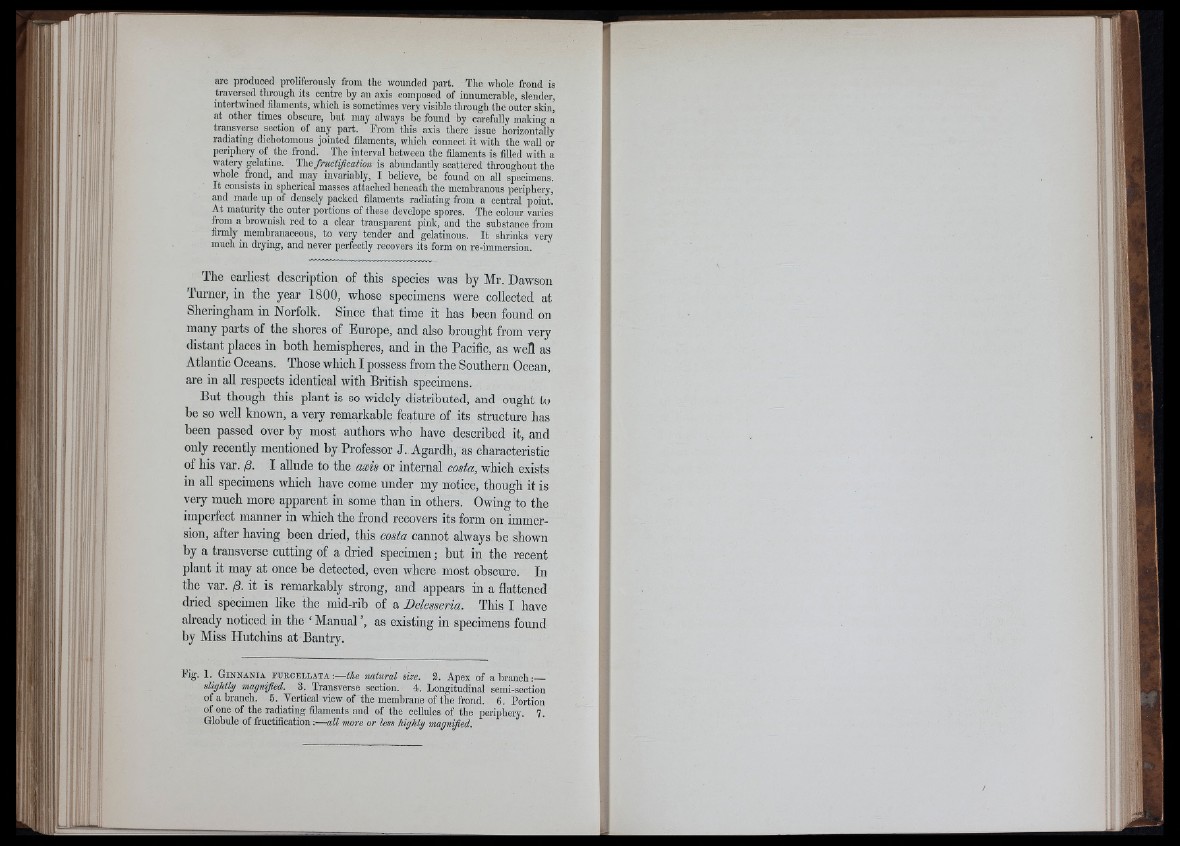
are produced proliferously from the wounded part. The whole frond is
traversed through its centre by nn axis composed of innumerable, slender,
intertwined filaments, which is sometimes very visible through the outer skin,
at otlier times obscure, but may always be found by carefully making a
transverse section of any part. From this axis there issue horizontally
radiating dichotomous jointed filaments, wliich connect it witli the wall or
periphery of^ the frond. The interval between the filaments is filled with a
wateiy gelatine. Xhs fructijlcation is abundantly scattered throughout the
whole frond, and may invariably, I believe, be found on all specimens.
I t consists in spherical masses attached beneath the membranous periphery,
and made up of densely packed filaments radiating from a central point.
At maturity the outer portions of these develope spores. The colour varies
from a brownish red to a cleai- transparent pink, and the substance from
firmly membranaceous, to very tender and gelatinous. I t sbilnks very
much in di-ying, and never perfectly recovers its form on re-immersion.
The earliest description of this species was by Mr. Dawson
Turner, in the year 1800, whose specimens were collected at
Sheringham in Norfolk. Since that time it has been found on
many parts of the shores of Europe, and also brought from very
distant places in both hemispheres, and in the Pacific, as well as
Atlantic Oceans. Those which I possess from the Southern Ocean,
are in all respects identical with British specimens.
But though this plant is so widely distributed, and ought to
be so well known, a very remarkable feature of its structure has
been passed over by most authors who have described it, and
only recently mentioned by Professor J. Agardh, as characteristic
of his var. I allude to the axis or internal costa, which exists
in all specimens which have come under my notice, though it is
very much more apparent in some than in others. Owing to the
imperfect manner in which the frond recovers its form on immersion,
after having been dried, this costa cannot always be shown
by a transverse cutting of a dried specimen; but in the recent
plant it may at once he detected, even where most obscure. In
the var. /3. it is remarkably strong, and appears in a flattened
dried specimen like the mid-rib of a Delesseria. This I have
already noticed in the ‘ Manual ’, as existing in specimens found
by Miss Plutchins at Bantry.
Fig. 1.^ G1NKANI.A ruRCELLATA '.— tU natural size. 2. Apex of a branch
slightly magnified. 3. Transverse section. 4. Longitudinal semi-section
of a branch. 5. Vertical view of the membrane of the frond. 6. Portion
of one of tbe radiating filaments and of the cellides of the periphery. 7 .
Globule of fructification:— all more or less highly magi ’
'i; A